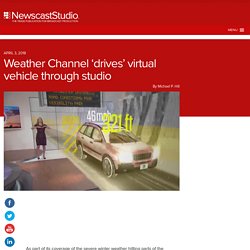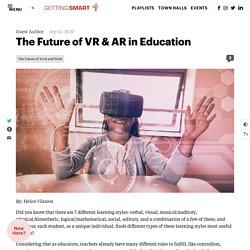

Examples of extended reality across industries. Heads-up display to give Soldiers improved situational awareness. WASHINGTON (Army News Service) -- A novel technology called "Tactical Augmented Reality," or TAR, is now helping Soldiers precisely locate their positions, as well as the locations of friends and foes, said Richard Nabors.

It even enables them to see in the dark, all with a heads-up display device that looks like night-vision goggles, or NGV, he added. So in essence, TAR replaces NVG, GPS, plus it does much more. Nabors, an associate for strategic planning at U.S. Why Every Organization Needs an Augmented Reality Strategy. There is a fundamental disconnect between the wealth of digital data available to us and the physical world in which we apply it.

While reality is three-dimensional, the rich data we now have to inform our decisions and actions remains trapped on two-dimensional pages and screens. This gulf between the real and digital worlds limits our ability to take advantage of the torrent of information and insights produced by billions of smart, connected products (SCPs) worldwide. Augmented reality, a set of technologies that superimposes digital data and images on the physical world, promises to close this gap and release untapped and uniquely human capabilities. 5 Innovative Examples Of Augmented Reality In Action. Weather Channel 'drives' virtual vehicle through studio - NewscastStudio.
Subscribe to NewscastStudio's newsletter for the latest in broadcast design and engineering delivered to your inbox.

As part of its coverage of the severe winter weather hitting parts of the country, The Weather Channel used augmented reality technology to showcase the hazards of driving in snow and ice. During a segment that aired Tuesday, April 3, 2018, the “brought” a virtual vehicle into the “AMHQ” studio through the use of Vizrt’s Viz Virtual Studio & Viz Engine. The vehicle appeared to be “driving” — albeit in place — with a snow covered road overlaid on the real studio floor. The path of the road continued in front of and behind the augmented vehicle, appearing to stretch into the studio’s real video wall.
To the right, the real studio walls were covered with a virtual, animated landscape that blended into the video wall background. The Promise of Immersive Learning: Augmented and Virtual Reality’s Potential in Education. Extended Reality In Education: The 5 Ways VR And AR Will Change The Way We Learn At School, At Work And In Our Personal Lives. It’s fair to say that a lot of teaching is based on presenting students with facts.

This means successful students tend to be those who retain facts easily, while students who struggle to process large amounts of information at one time can quickly become disengaged. This arguably applies to all types of learners, whether it’s in a school setting, on a workplace training course, or in lifelong learning. Some people are visual learners, after all, which means the ability to “see” a process (rather than read or hear about it) is far more impactful for them. This is where virtual reality (VR) and augmented reality (AR) can add real value to the learning process. 10 Best Examples Of VR And AR In Education. Extended reality (XR for short) – which encompasses virtual reality, augmented reality and mixed reality – uses technology to create more immersive digital experiences.

In my latest book, Extended Reality In Practice, I look at a variety of sectors where XR is being used, and one of my favorite sectors is in the world of education. In this post, I'm going to give you my ten favorite examples of how educators and researchers are using augmented and virtual reality to help students learn and engage in the classroom and beyond. 1. Bringing science concepts to life with augmented reality. We can now use augmented reality to create a tornado, then bring the funnel right into the classroom so students can experience these destructive storms close up. Virtual Reality in Education - ClassVR.
This website uses a number of cookies so that we can provide you with the best user experience possible.

Cookie information is stored in your browser and performs a number of functions, such as recognising you when you return to our website, and helping our team to understand which sections of the website you find most interesting and useful. Please navigate through the sections on the right to learn more detail about the specific cookies that are in use on this website, where you can disable them if you wish. Please note that doing so, may cause certain features on the website to stop working correctly.
This website uses a number of cookies so that we can provide you with the best user experience possible. 21 awesome AR and VR tools for learning. Nearly everyone has experienced augmented reality and virtual reality to some degree, and while they’re fun, AR and VR can also be incredibly powerful when integrated into classroom learning.

During an engaging ISTELive 21 session, Jennifer Hall, NBCT, an educational technology specialist with Atlanta Public Schools, outlined an abundance of AR and VR apps for students and educators. Augmented reality is the idea that you’re bringing something into your real world and using your device to see something that isn’t actually there. Animation or 3D images come into your real world. Virtual reality is where a person is immersed in the experience, as if they’re actually there.
The Future of VR & AR in Education - Getting Smart. By: Helen Vlasova Did you know that there are 7 different learning styles: verbal, visual, musical/auditory, physical/kinesthetic, logical/mathematical, social, solitary, and a combination of a few of these; and moreover, each student, as a unique individual, finds different types of these learning styles most useful to them?

Considering that as educators, teachers already have many different roles to fulfill, like controllers, organizers, creators, prompters, and assessors, on top of the fact that the number of schools that are experiencing overcrowding continues to increase, it is more than obvious that teachers are in desperate need of tools that will help them not only ease the process of learning, but also modernize it, bring it closer to the student’s interests, and adjust it in a way that students with different learning styles will find the lesson equally useful and beneficial. VR & AR are Becoming the Future of Education.